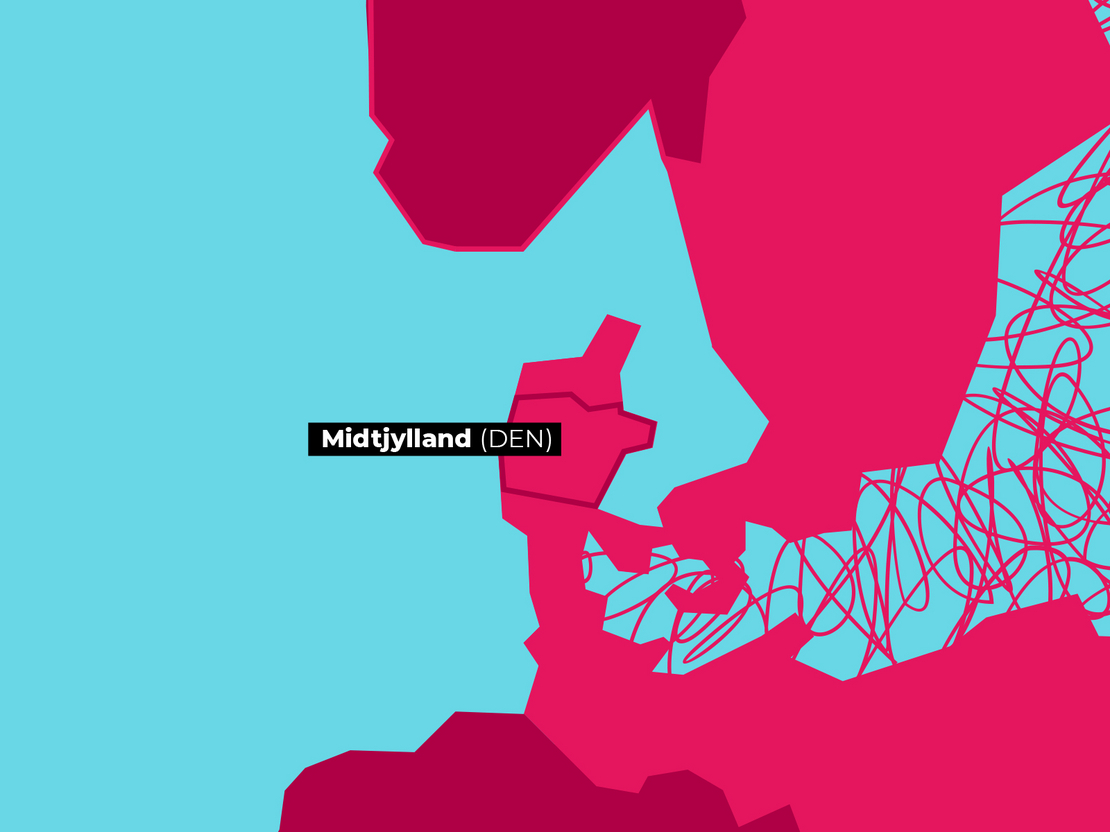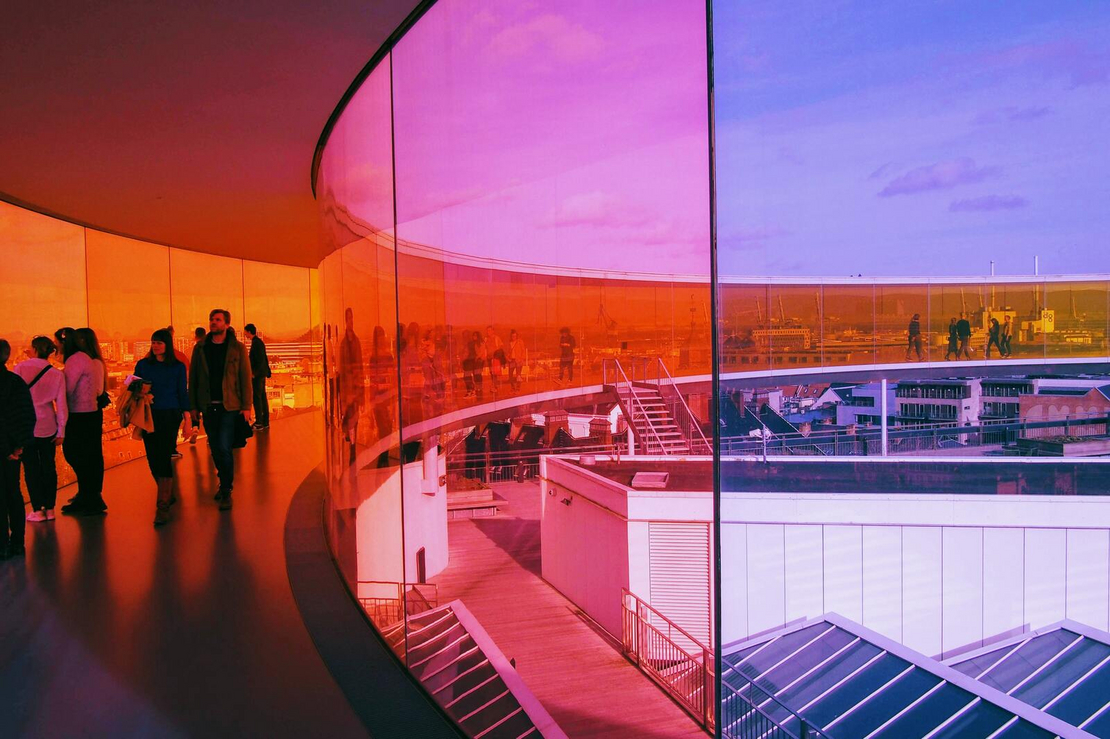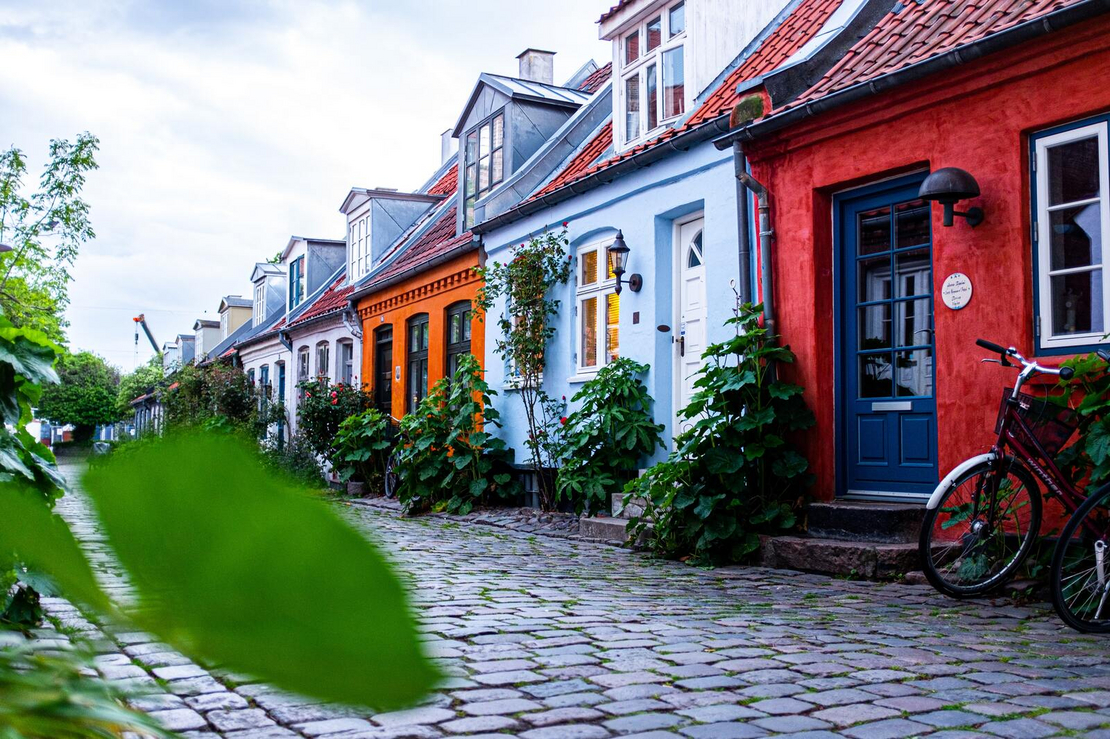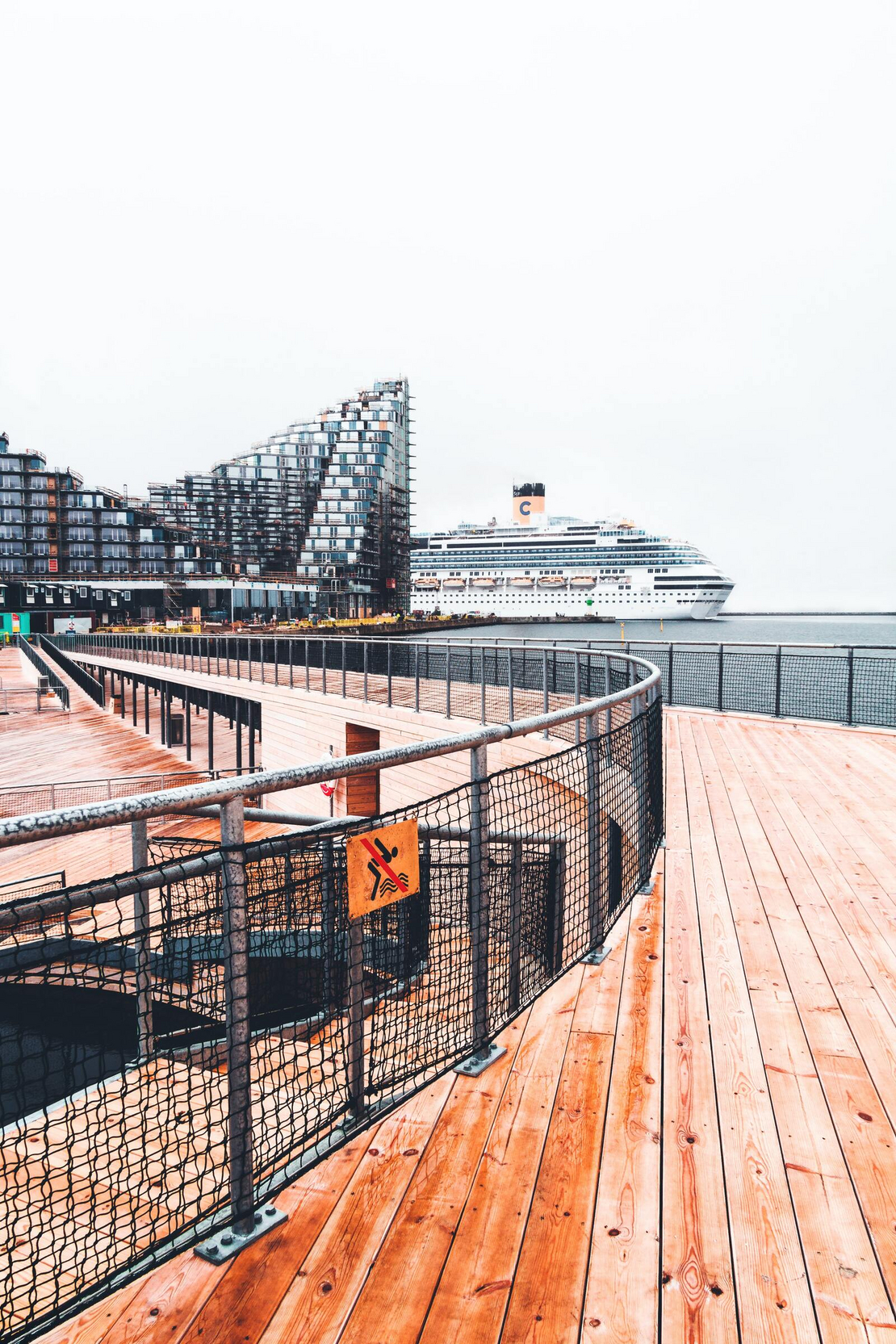Region Midtjylland, Denmark
| NUTS code | DK04 |
|---|---|
| Population | 1.31 Million |
| Area in km² | 13.053 km² |
| GDP/inhabitant (year) | 32.400€ (2016) |
| GDP growth rate (year) | 1.7% (2016) |
| Unemployment rate (year) | 5.3% (2017) |
| Cohesion Policy category | More developed region |
Number of support organisations in the region: 8
Global creativity index – GCI, country level: 0.878 (2015)
Regional Entrepreneurship Development Index – REDI: 58.2 (2017)
1. Introduction
Numerous Danish cultural and art institutions, artists' associations and regional administrations engage in international cultural exchange programmes. Most importantly, artists, curators and cultural institutions from all branches of the arts cultivate international contacts and networks, resulting in performances and exhibitions, as well as invitations to foreign artists to visit Denmark. In spite of the interest in CCI as a growth industry, there is still no fixed definition of what the national sectors represent. The overall aim is to support the creative arts, cultural education and research, cultural heritage, media and others. The 11 business sectors together constitute the national cultural economy and each one represents a cohesive system of producers, associated businesses and services: architecture, books & press, design, film & video, digital content production & computers, arts & crafts, music, fashion & clothing, furniture & interior design, radio & TV and advertising.
2. General information about Midtjylland
There are several initiatives to increase the growth in CCI throughout the region, especially around the Aarhus area. In 2018, the mapping of the Creative and Cultural Industries in Region Midt was part of political initiatives to understand the potential and growth barriers for creative businesses in Central Denmark. For example, Filmby Aarhus, a local hub for creative and cultural businesses, has been active in promoting the film industry. The hub’s strategy to 2020 called The Big Picture, centres around facilitating the meeting between digital creative content and traditional sectors who can benefit from using digital content, and it describes how businesses and education within the digital visual sector play an active role in community development in Denmark today.
3. Economy
Creative industries make up a significant share of the Danish economy. In 2016 they employed approx. 86,000 persons in service as well as manufacturing, and had revenue of about DKK 200 billion. The CCI thus represent 6-7 per cent of total revenue and employment in Danish business and industry. Danish design and architecture is world renowned, and in recent years the Danish fashion & clothing sector has seen significantly increasing revenue and internationalization. Danish films and TV programmes have won numerous international awards, which has helped attract tourists and talent to the country as well as strengthening Denmark's international brand as a creative nation.
Economic importance of CCI in the region
In Region Midt, there are ca. 5.670 creative businesses. These enterprises make up 12 % of all business within the region, and 14 % of the region’s export shares. The key regional CCI sub-sectors in Region Midt are Architecture, Design, Digital Visual Industries, Performing Arts and Cultural Heritage. Businesses from the digital visual industry are known for being especially smart at creating empathy and interaction with the help of audio-visual narratives – and it is precisely these skills that are the decisive components in three current trends in the community economy. In recent years, Region Midt has increased its focus on developing CCI and related business initiatives. Cross-cultural partnerships such as Kulturby 2017 (Culture City) has proven to be an important driver for CCI development in the region. Kulturby 2017 was a collective project between Aarhus and 18 other municipalities in the Central Denmark Region, when Aarhus was selected European Capital of Culture in 2017. The project funded cultural and creative initiatives across the region with a 159,1 million Euro increase in turnover for the private sector resulting in ca. 2000 new full-time employments. Such cross-cultural partnerships have proven to be vital for the further business development of the CCI in the region.
International links
The CCI sector’s main international links are shown in Table 1. The regional CCI participates in collaborations with public cultural heritage institutions such as ARoS (Aarhus Art Museum), MOMU (Moesgaard Museum of Ethnography), libraries and more. Regional CCI also participate in several international fairs, creating business links across the BSR region. These include:
| International Links | Business links |
|---|---|
| Games Week (DK) | EU Interreg BSR “Cross Motion” |
| Internet Week Denmark (DK) | EU Interreg NSR “Create Converge” |
| this. festival (DK) | Creative Business Network |
| Berlinale (DE) | |
| SLUSH (FIN) | |
| Kiel Waterkant Festival (DE) |
4. Regional business eco-system
In June 2010, a report on the government's strategy on promoting Danish arts and culture internationally was launched. Since then the municipalities have been given the full political, administrative and financial responsibility to handle cultural institutions and activities with a local affiliations. Under the Ministry of Culture, many institutions operate to support and promote the industry – internally and abroad. As the Danish Design Centre works to promote the international branding of craft and design and help Danish professionals gain a foothold in the international market. The DFI (Danish Film Institute) provides funding and promotion for film art, film culture and cinema culture, as well as festivals, game production, and television production.
Types of support
In addition to artists' fees, private donations and corporate sponsorships, government funding is available to artists who engage in international cultural exchanges. The Danish Arts Council provides financial support for the promotion and awards grants based on applications such as the participation of Danish artists in events abroad, and visiting programmes for artistic or cultural representatives from abroad. The Danish Arts Council also supports the presentation of significant foreign art in Denmark through grant-programme for artists-in-residence called DIVA and supports foreign artists in the visual arts, music, performing arts and literature, invited by Danish culture and arts institutions to work and exhibit locally.
| CCI Support Organization | Types of Support | Important CCI projects, programs, partnerships |
|---|---|---|
| Filmby Aarhus | Administration of funding in Vestdanske Filmpulje, business and talent development | Vision Denmark Create Converge Cross Motion Ideas Lab / Incubator Interactive Denmark Vest |
| Interactive Denmark Vest | Capital Attraction, Talent building, network and knowledge sharing, industry business development | CPH MatchUp 2020 SpillBar 40: Stories |
| Aarhus 2017 legacy | Capital Attraction, industry business development, cultural projects, events | More Creative Off Track |
| Game Hub Scandinavia | Industry business development in Scandinavia | The Animation Workshop Game Hub Denmark GROW Aalborg |
| Creative Business Network | International case competitions, talent development, networking | Creative Business Cup |
| Nordic Fashion Association | Enhance inter-Nordic cooperation in the fashion industry, industry business development | Nice (Nordic Initiative for Clean and Ethical Fashion), SFA (The Sustainable Fashion Academy) |
| Danish Fashion Institute (CFA) | Leadership forum for industry collaboration, events | Copenhagen Fashion Summit |
| Danish Film Institute (DFI) | Support for up to 25 feature movies, 30 and documentary and short films and video games a year via Film Commissioner Scheme, Market Scheme, New Danish Screen and Games support schemas. | International film festivals; Danish Embassies and Consulates around the world; Bodil Awards, Buster, Copenhagen Jewish Film Festival, Copenhagen TV Festival. |
| Promus | Network and innovation processes in music environments in Aarhus, events, mentoring | Spot + Aarhus Volume Music City Aarhus |
5. CCI in the region - Overview of the role of CCI sector in regional business
Apart from Filmby Aarhus, in the Region Midt there are 5 more “hubs” and 2 large CCI companies.
CCI support and development system
The Danish Arts Foundation offers more than 60 different funding programs, they fund the production and promotion of both visual arts, film, literature, music, performing arts, architecture, crafts and design – and all that transcends the borders of these art forms. Danish design and architecture is world renowned, and in recent years the Danish fashion & clothing sector has seen significantly increasing revenue and internationalization. Danish films and TV programmes have won numerous international awards, which has helped attract tourists and talent to the country as well as strengthening Denmark's international brand as a creative nation. Internationally, the creative industries have seen strong growth in the past decade, reflecting factors such as new information and communication technologies.
CCI sector in regional business
| Name | Location | Sector | Facilities |
|---|---|---|---|
| Filmby Aarhus https://filmbyaarhus.dk/ | Aarhus | DVI, cross-sectoral partnerships | Business Park with over 60 companies, studio facilities, education and training facilities |
| Game Hub https://gamehubdenmark.com/ | Grenaa | DVI (gaming) | Incubation and business development in computer game start-ups, office spaces and training facilities |
| Lydhavnen http://lydhavnen.dk/ | Aarhus | Performing Arts (Music) | Audio Facilities, studios, cluster with 12 production companies and producers |
| Arsenalet https://www.arsenalet.dk/ | Viborg | DVI (animation) | Educational facilities animation company cluster with ca. 40 animation and graphic design businesses, office spaces and meeting facilities |
| Lifestyle and Design Cluster https://ldcluster.com/ | Herning Aarhus | Design, fashion | The innovation network Lifestyle & Design Cluster works to promote innovation and sustainable growth primarily in the small and medium-sized housing and clothing companies as well as in the creative industries. |
| “Bestseller” https://about.bestseller.com/ | Brande | Fashion | One of Denmark’s biggest clothing and design enterprises has its headquarters here, also attracting other business within the Fashion and Design sub-sector |
| “Lego” https://www.lego.com/da-dk/aboutus/lego-group/management | Billund | Design | One of Denmark’s biggest companies has its headquarters here, also attracting other business within the Design and IT sub-sectors |
6. Knowledge base and skills
Many of the CCI in Denmark are organized in industry and trade associations with the main purpose to secure working conditions and gain political influence by promoting members’ interests. However, many working groups are yet to be formally organized in unions or trade organizations, which shows the ongoing professionalization of CCI as it expands unto new technologies or sub-sectors.
| Education and training programs | Sector |
|---|---|
| VIA University College: The Animation Workshop | DVI |
| VIA University College: Multiplatform storytelling and production | DVI |
| VIA University College: Design and Business | Design |
| Aarhus Arkitektskole | Architecture |
| Aarhus University | Various |
| Danish Talent Academy (Holstebro) | Performing Arts |
| Balletskolen (Holstebro) | Performing Arts |
| Aarhus School of Design (Design) | Design |
| Super 8 (Film Production) (Aarhus) | DVI |
| Dox: World (Web and documentary production) (Aarhus) | DVI |
| Det jyske musikkonservatorium (Aarhus) | Performing Arts |
| Danmarks medie -og journalisthøjskole (Aarhus) | DVI |
| Aarhus Kunstakademi (Aarhus) | Performing Arts |
7. Regional CCI development outlook
The establishment and development of CCI in Region Midt can be summed up in four main tendencies, which both represent possibilities as well as challenges for further growth:
- CCI in Region Midt and in Denmark in general, has been dependent on a strong political engagement to secure and support cultural production, especially through public service broadcasting and proactive cultural policy. This continues to influence the political focus and support for CCI in Denmark. It is evident, that public funding and policy remains crucial to the development of private CCI and promoting cultural work and products.
- An enhanced political focus is detected on supporting the DVI sub-sectors. Other sub-sectors such as Performing Arts (Theatres, Dance and Music) and Cultural Heritage (Museums and libraries) are mainly publicly funded institutions, whereas DVI is mainly driven by private entrepreneurship, and proves to be a high-potential economic growth area for cross-sectoral collaboration as well. Also, the export potential of DVI products have proven to be a political and industrial focus.
- Cross-sectoral and cross-cultural partnerships have proven to be vital for the further business development of the CCI in the region. Projects such as Kulturby 2017 and business initiatives such as Filmby Aarhus drive the incubator environments in many sub-sectors. Local business clusters have proven to increase the awareness and business development potential in many regional municipalities.
- Copenhagen is still the main hub and main work environment for CCI industries in Denmark. The imbalance between regional CCI and Copenhagen in terms of influence and decision-making is a main issue. Thus, the network for CCI related work and employment has yet to prove its full potential due to a smaller work force and un-developed working culture in various sub-sectors. Regional CCI needs to maintain a sustainable production volume to retain talent and businesses, and to define its own unique profile so that regional CCI becomes the first port of call for international collaborations.
References
- Kulturministeriet (2012): Danske museer i tal.
- Kulturministeriet (2015): Folkebiblioteker i tal.
- Meyer; Andersen (2017): Analyse af de kreative erhverv. https://www.danskerhverv.dk/siteassets/mediafolder/downloads/analysenotater-2017/analysenotat---analyse-af-de-kreative-erhverv-september-2017
- Producentforeningen (2018): Danske Indholdsproducenter i tal: https://pro-f.dk/sites/pro-f.dk/files/side/Danske%20Indholdsproducenter%20i%20tal%202018_0.pdf
- Regeringen (2013): Danmark I Arbejde. Vækstplan for kreative erhverv.
- Vision Denmark (n.e): Strategi for Danmarks digitale visuelle industry. Fra en verden I tekst til en verden i billeder
- Vækstteam for kreative erhverv til Regeringen (2018): Danmark: Et international førende vækstmiljø for kreative erhverv
- Filmby Aarhus (2016): The Big Picture. Fra filmby I Aarhus til samfundsudvikling I Danmark https://issuu.com/filmbyaarhus/docs/thebigpicture
- Filmby Aarhus (2018): Film skal ses I virkeligheden. En håndbog om filmturisme https://dagsorden-og-referater.brk.dk/Sites/Politiske_Internet/Internet/2018/InfRef7926-bilag/Bilag1826416.PDF
- First Motion (2012): Value Chains and Business Models in the Audiovisual Sector in the North and Central Denmark Regions.
- More Creative (2018): Omfanget og betydningen af den kreative økonomi I Region Midtjylland og Danmark. Seismonaut
- https://businessaarhus.dk/om-aarhus/styrkepositioner-i-aarhus/kreative-erhverv/
- Aarhus2017 (2017): Welcome Future. Short-term impact of European Capital of Culture Aarhus 2017:
- http://www.aarhus2017.dk/media/12979/welcome_future_eng_online.pdf






